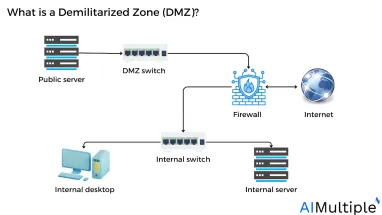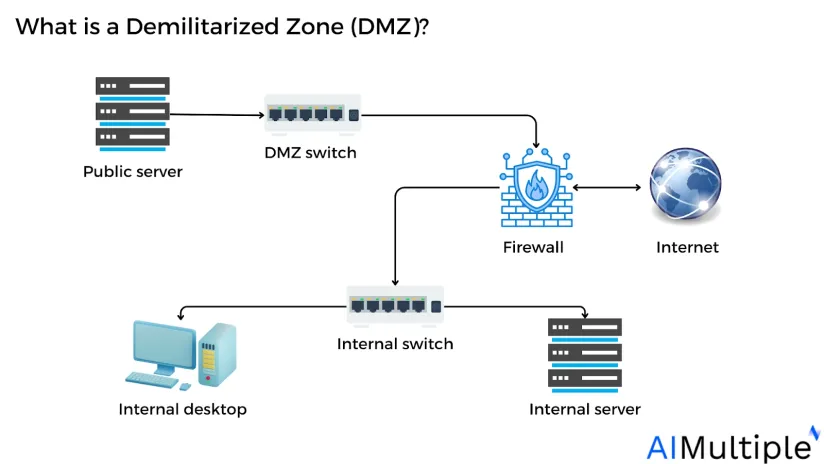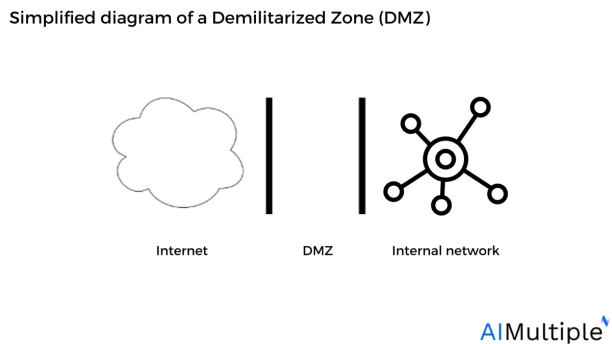DMZ Network Security in 2024: How it Works & 3 Benefits


The number of data breaches in the U.S. was more than 1800 in 2022 and 422+ million people got exposed to data compromises that year.1
Implementing data isolation policies is crucial to enhance network visibility and prevent the most common cyber attack vectors. To accomplish isolation, companies can use the Demilitarized Zone (DMZ) to enhance network security and secure sensitive data against cyber threats and risks.
The purpose of this article is to give IT and security professionals guidance on the importance, design, and benefits of DMZ.
What is Demilitarized Zone (DMZ) network security?
A Demilitarized Zone (DMZ) network, also known as a perimeter network, is a subnetwork containing an organization’s publicly accessible services. It serves as an exposed point to an untrusted network, often the Internet.
The purpose of a DMZ is to provide an additional layer of protection to an organization’s local network. A secured and controlled network node facing outside the internal network may see what is accessible in the DMZ, while the other part of the organization’s network is secured by a firewall.
When correctly configured, a DMZ network provides additional protection to companies by detecting and reducing security breaches before they reach internal systems, where critical assets are kept.
Why is DMZ network security important?
DMZs add a layer of network segmentation to assist defend internal operational technology across business networks. These subnetworks limit external access to internal servers and assets, making it more challenging for attackers to penetrate the internal network. This method is appropriate for both individual usage and large companies.
A DMZ is designed to achieve two primary objectives:
1. The first step is to segregate public access assets from the rest of your network.
2. The second step is to minimize complexity.2
Read more: Mandatory access control (MAC), role-based access control (RBAC).

How does a DMZ work?
The DMZ works by allowing secure connection between protected company resources, such as internal databases, and authorized Internet traffic.
DMZ creates a buffer zone between the public internet and private networks and the DMZ subnet is configured between two firewalls. All internal network packets are then inspected by a firewall or other security appliances before being sent to the DMZ servers.
Demonstration of a DMZ implementation
DMZ example 1
As seen in Figure 1, the DMZ network is neither within nor outside the firewall. It is accessible through both internal and external networks. Security regulations restrict external devices from connecting to internal devices. A DMZ is more protected than an external network, but less protected than an internal one.
Figure 1: Simple DMZ diagram

Source: International Journal of Wireless and Microwave Technologies3
In this network, arrangement the firewall is as follows:
Inside network: The internal network can start connections to external networks, but the network cannot start connections to the internal network.
Outside network: The outside network cannot establish connections with the inner network, however, the outside network can begin connections to the DMZ.
DMZ: The DMZ may connect to the outside network, but not to the inside network, and any additional network is allowed to start communications with the DMZ.
One of the primary advantages of this network diagram is isolation. For example, If the email server is hacked, the attacker will be unable to access the internal network. In this scenario, the attacker may access various servers in the DMZ as they share the same physical network.
Additionally, to further isolate servers, organizations can leverage DMZ switch capabilities like private VLANs, port ACLs, and VLAN connections.
DMZ example 2: A DMZ connected to a vendor
Another typical DMZ approach is connecting to a third-party, such as a vendor. Figure 2 depicts a network with a vendor linked by T1 to a router in the DMZ.
This DMZ example can be used when companies outsource their systems to an outside party, allowing access to the vendor’s server via this setup.
Figure 2: DMZ connecting to a vendor

Source: O’Reilly Media4
For example 2, the firewall should be set as follows:
Inside network: The inside network may start connections to external networks, but other networks cannot start connections to the inside network.
Outside network: The outside network cannot establish connections to the inside network or DMZ and the inside network may start connections to the outside network, whereas the DMZ cannot.
DMZ: The DMZ cannot establish connections to any network and only the internal network may start connections to the DMZ.
DMZ example 3: Multiple DMZs connected to a vendor
Sometimes a single DMZ is insufficient for organizations that operate complex networks. Figure 3 depicts a network that has several DMZs. The design combines the first two examples. The Internet is outside, and the users are within the network.
Figure 3: Multiple DMZs

Source: O’Reilly Media5
DMZ-1 is an access point to a vendor. DMZ-2 is where the Internet servers are located. The security criteria remain the same as in the previous section (example 2), but it must additionally be evaluated whether DMZ-1 is allowed to start connections to DMZ-2 and vice versa(in this scenario, the DMZs cannot initiate connections with each other).
For example 3, the firewall should be set up as follows:
Inside network: The inside network may start connections to any other network; nevertheless, no other can start connections to the inside network.
Outside network: The outside network cannot create connections to the inside network or DMZ-1, however, the outside network can establish connections to DMZ-2.
DMZ-1: DMZ-1 cannot establish connections to other networks and connections to DMZ-1 and DMZ-2 can only be initiated from the inside network.
DMZ-2: DMZ-2 can only make connections to the outside network and both the outside and internal networks can establish connections to DMZ-2.
DMZ architecture
A DMZ can be configured in a variety of ways, ranging from a single firewall to dual or multiple firewalls. The majority of current DMZ architectures include twin firewalls that can be scaled to support complex networks.
1. Single firewall
A single firewall with at least three network interfaces is needed to build a network architecture that includes a DMZ.
- The external network is built from the Internet Service Provider (ISP) to the firewall on the first network interface,
- The internal network from the second network interface, and the DMZ from the third network interface.
- The firewall serves as the network’s single point of failure, and it must be able to manage all traffic to and from the DMZ and internal networks.
Figure: Illustration of a single firewall architecture

Source: SAP6
2. Dual firewall
This implementation creates a DMZ using two firewalls.
- The first firewall (also known as the “front-end” firewall) should only enable traffic received from the DMZ.
- The second firewall (sometimes known as the “back-end” firewall) should only enable traffic received from the DMZ into the internal network.
Figure: Illustration of dual firewall architecture

Source: SAP7
Why to use dual firewalls: Dual firewalls offer a more secure system. In some companies, the two firewalls are offered by separate providers. If an attacker can breach the first firewall, it may take longer to breach the second one if it is built by a different manufacturer, making it less likely to fall victim to the same vulnerabilities.
Benefits of Demilitarized Zone (DMZ)

A DMZ’s principal value is that it provides public internet users with access to specific protected services while acting as a barrier between those users and the company’s internal network.
This line of defense provides various security benefits:
Access control: A DMZ network controls access to services accessible over the internet that are not within a company’s network perimeter. It also adds a layer of network segmentation, increasing the amount of barriers a user must overcome before getting admission to a company’s private network. In certain circumstances, a DMZ contains a proxy server, which regulates the transmission of internal internet traffic (typically from employees) and simplifies network audit and monitoring.
Prevent network reconnaissance: A DMZ additionally prohibits an attacker from assessing prospective targets on the network. Even if a machine in the DMZ is hacked, the internal firewall defends the private network by isolating it from the DMZ. This configuration makes external network exploits more difficult.
Although the DMZ servers are publicly revealed, they are protected by an additional layer of security. The public face of the DMZ prevents attackers from viewing any information on the internal private network. If attackers attempt to breach the DMZ’s servers, the internal barrier keeps them separated from the private network.
Limiting Internet Protocol (IP) spoofing: Attackers try to obtain unauthorized access to networks by spoofing an IP address of an authorized device logged into a network. A DMZ can detect and prevent such spoofing efforts while another service checks the IP address’s validity. The DMZ also allows network segmentation ( e.g. OT network segmentation, microsegmentation) to arrange traffic and allow public services to be accessible outside of a company’s private network.
Applications of DMZs
DMZs are utilized in a variety of ways, including
Cloud services: Some cloud services employ a hybrid security strategy in which a DMZ is established between the company’s on-premises network and its logical network. This strategy is commonly employed when the company’s services run partially on-premises and partially over a logical network. It is also used to audit outbound traffic or to provide granular traffic management between the logical network and the on-premises data center.
Home networks: A DMZ can also be useful for home networks that use LAN settings and broadband routers. Several household routers include DMZ options or DMZ host settings. These options enable users to connect only one device to the internet. As part of the DMZ host feature, machines on home networks are configured to run outside firewalls and other network devices stay within the firewall.
Industrial control systems (ICS): DMZs may provide a solution to the security problems associated with ICS.
Most of the operational technology (OT) equipment that connects to the internet is not as well-designed for mitigating attacks as IT devices are. A DMZ can strengthen OT network segmentation, making it more difficult for malware, viruses, or other network threats to traverse the gap between IT systems and their less secure OT equivalents.
Read more: Top 10 insider threat management software.
For guidance on choosing the right tool or service, check out our data-driven lists of unified threat management (UTM) software.
Further reading
- Top 10 Microsegmentation Tools
- Microsegmentation: What is it? Benefits & Challenges
- Role-based access control (RBAC)
- Network Segmentation: 6 Benefits & 8 Best Practices
- 80+ Network Security Statistics
- Network Security Policy Management Solutions (NSPM)
- Cybersecurity Risk Management
AIMultiple can assist your organization in finding the right vendor for firewall audit and cybersecurity needs. Feel free to reach out to us:
External links
- 1. ”Annual number of data compromises and individuals impacted in the United States from 2005 to 2022“. Statista. February 1, 2024. Retrieved February 6, 2024.
- 2. ”The Science DMZ: A network design pattern for data-intensive science“. (PDF). Proceedings of the International Conference on High Performance Computing, Networking, Storage and Analysis. August 14, 2014. Retrieved February 6, 2024.
- 3. ”Evaluation the Performance of DMZ“. (PDF). International Journal of Wireless and Microwave Technologies. January 2018. Retrieved February 6, 2024.
- 4. ”Network Warrior“. (PDF). O’Reilly Media. May 2011. Retrieved February 6, 2024.
- 5. ”Network Warrior“. (PDF). O’Reilly Media. May 2011. Retrieved February 6, 2024.
- 6. ”Understanding DMZ and Firewall“. SAP. 2024. Retrieved February 6, 2024.
- 7. ”Understanding DMZ and Firewall“. SAP. 2024. Retrieved February 6, 2024.

Cem is the principal analyst at AIMultiple since 2017. AIMultiple informs hundreds of thousands of businesses (as per Similarweb) including 60% of Fortune 500 every month.
Cem's work has been cited by leading global publications including Business Insider, Forbes, Washington Post, global firms like Deloitte, HPE, NGOs like World Economic Forum and supranational organizations like European Commission. You can see more reputable companies and media that referenced AIMultiple.
Throughout his career, Cem served as a tech consultant, tech buyer and tech entrepreneur. He advised enterprises on their technology decisions at McKinsey & Company and Altman Solon for more than a decade. He also published a McKinsey report on digitalization.
He led technology strategy and procurement of a telco while reporting to the CEO. He has also led commercial growth of deep tech company Hypatos that reached a 7 digit annual recurring revenue and a 9 digit valuation from 0 within 2 years. Cem's work in Hypatos was covered by leading technology publications like TechCrunch and Business Insider.
Cem regularly speaks at international technology conferences. He graduated from Bogazici University as a computer engineer and holds an MBA from Columbia Business School.
Sources:
AIMultiple.com Traffic Analytics, Ranking & Audience, Similarweb.
Why Microsoft, IBM, and Google Are Ramping up Efforts on AI Ethics, Business Insider.
Microsoft invests $1 billion in OpenAI to pursue artificial intelligence that’s smarter than we are, Washington Post.
Data management barriers to AI success, Deloitte.
Empowering AI Leadership: AI C-Suite Toolkit, World Economic Forum.
Science, Research and Innovation Performance of the EU, European Commission.
Public-sector digitization: The trillion-dollar challenge, McKinsey & Company.
Hypatos gets $11.8M for a deep learning approach to document processing, TechCrunch.
We got an exclusive look at the pitch deck AI startup Hypatos used to raise $11 million, Business Insider.
To stay up-to-date on B2B tech & accelerate your enterprise:
Follow on


Comments
Your email address will not be published. All fields are required.